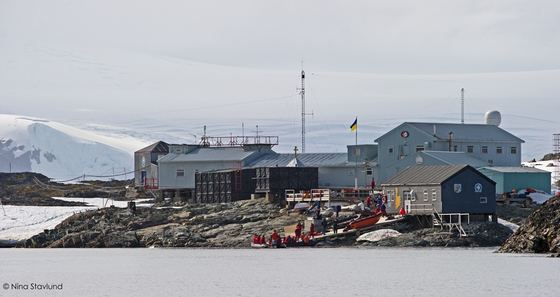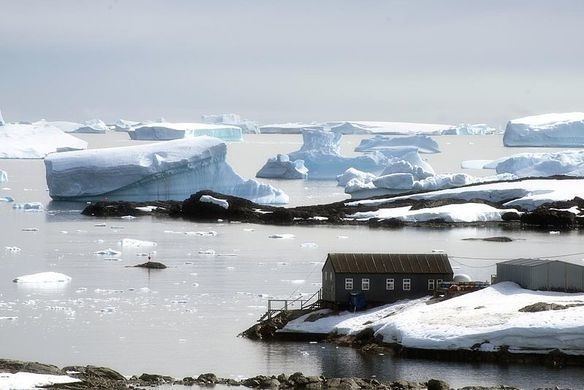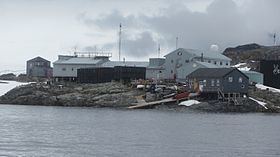Country Ukraine Named for Vladimir Vernadsky | Location Galindez Island | |
 | ||
Islands of Antarctica Wilhelm Archipelago, Argentine Islands Region Graham Land, Antarctic Peninsula Established 1947 (by the United Kingdom) Founded February 1996 (1996-02) | ||
Vernadsky research base 25 12 2015 r
The Vernadsky Research Base (Ukrainian: Академік Вернадський) is a Ukrainian Antarctic Station at Marina Point on Galindez Island in the Argentine Islands, Antarctica. It is named after Soviet and Ukrainian mineralogist Vladimir Vernadsky.
Contents
- Vernadsky research base 25 12 2015 r
- United Kingdom
- Ukraine
- The building
- Staff
- Climate research
- Services
- References
United Kingdom

The station was established by the British Falkland Islands Dependencies Survey as Base F, or "Argentine Islands", on Winter Island in 1947.

The main hut, built on the site of an earlier British Graham Land Expedition hut, was named "Wordie House" after Sir James Wordie, a member of Shackleton's Imperial Trans-Antarctic Expedition who visited during its construction.
Wordie House has been restored and is designated as Historic Site and Monument No. 62. The base moved to the present site on adjacent Galindez Island in May 1954 where the main building was named "Coronation House".
The base was renamed Faraday Station in August 1977 in honour of British scientist Michael Faraday.
Ukraine
Ukraine took over the operation of the base in February 1996, which was sold by the UK for a symbolic one pound. The cost of disassembling the base with good environmental practices and standards would be too costly. The National Antarctic Scientific Center of Ukraine continues a programme of meteorology, upper atmospheric physics, geomagnetism, ozone, seismology, glaciology, ecology, biology and physiology research.
The building

The station consists of nine buildings standing on rock foundations. A 1961 extension at the east end of the hut provided living quarters for 15 people. Major alterations in 1980 updated the living and working accommodation. A two-storey extension provides sleeping accommodation for 24 people, a clothing store, boiler room and reverse osmosis plant on the ground floor. Upstairs are a lounge, library, dining room, gift store and kitchen. The lounge is considered the southernmost public bar in the world, where visitors could purchase $3 shots of horilka (made on the premises) up until 2016. The old part of the building is now mostly laboratories and work rooms, together with the surgery and washrooms. The generator shed was erected in 1978-79, with the old one now used as a frozen food store and a carpenter's workshop. Other buildings include two non-magnetic buildings, a balloon launching shed (now skidoo garage), and a general store.
Staff
During 2013-14, Vernadsky Station is staffed by 12 Ukrainians who make up the XVIII Ukrainian Antarctic Expedition.
Climate research
As one of the longest operating bases in Antarctica, Vernadsky Station has been the subject of scientific research studies on long-term temperature trends that indicate global warming. A study published in the April 2013 issue of the International Journal of Climatology examined the daily observed temperature at the Faraday/Vernadsky station from 1947 to 2011. It concluded that “Faraday/Vernadsky is experiencing a significant warming trend of about 0.6°C/decade (1.1°F) over the last few decades. Concurrently, the magnitude of extremely cold temperatures has reduced.”
Services
Vernadsky Station operates several services for visiting tourists. A post office accepts postcards at a cost of US$2 each. This is one of only a few post offices where visitors may send mail from Antarctica. Stamps for letters cost $6. Mail will take several months to be delivered. In addition to selling postage and accepting outgoing mail, the post office sells commemorative postcards and envelopes for $2 to $3 each.
